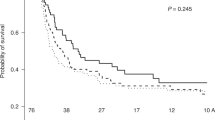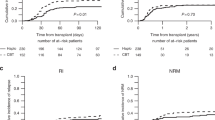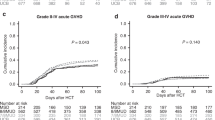Abstract
Donor–recipient sex incompatibility has been associated with transplant outcomes in allogeneic hematopoietic SCT. Such outcomes might be because mHA encoded by Y chromosome genes could be immunological targets for allogeneic T cells and B cells to induce GVHD, GVL effect and graft failure. However, its effect on the outcome of cord blood transplantation (CBT) is yet to be clarified. We retrospectively analyzed 191 adult patients who received single-unit CBT after myeloablative conditioning for malignant disease in our institute. In multivariate analysis, male recipients with female donors had a higher incidence of extensive chronic GVHD (hazard ratio (HR) 2.97, P=0.02), and female recipients with male donors had a lower incidence of platelet engraftment (HR 0.56, P=0.02) compared with female recipients with female donors as the reference. Nevertheless, there was no increase in mortality following sex-incompatible CBT. These data suggested that donor–recipient sex compatibility does not have a significant impact on survival after myeloablative CBT for hematological malignancies.
This is a preview of subscription content, access via your institution
Access options
Subscribe to this journal
Receive 12 print issues and online access
$259.00 per year
only $21.58 per issue
Buy this article
- Purchase on Springer Link
- Instant access to full article PDF
Prices may be subject to local taxes which are calculated during checkout

Similar content being viewed by others
References
Warren EH, Zhang XC, Li S, Fan W, Storer BE, Chien JW et al. Effect of MHC and non-MHC donor/recipient genetic disparity on the outcome of allogeneic HCT. Blood 2012; 120: 2796–2806.
Gahrton G . Risk assessment in haematopoietic stem cell transplantation: impact of donor-recipient sex combination in allogeneic transplantation. Best Pract Res Clin Haematol 2007; 20: 219–229.
Gratwohl A, Hermans J, Niederwieser D, van Biezen A, van Houwelingen HC, Apperley J . Female donors influence transplant-related mortality and relapse incidence in male recipients of sibling blood and marrow transplants. Hematol J 2001; 2: 363–370.
Randolph SS, Gooley TA, Warren EH, Appelbaum FR, Riddell SR . Female donors contribute to a selective graft-versus-leukemia effect in male recipients of HLA-matched, related hematopoietic stem cell transplants. Blood 2004; 103: 347–352.
Gahrton G, Iacobelli S, Apperley J, Bandini G, Björkstrand B, Bladé J et al. The impact of donor gender on outcome of allogeneic hematopoietic stem cell transplantation for multiple myeloma: reduced relapse risk in female to male transplants. Bone Marrow Transplant 2005; 35: 609–617.
Gallardo D, Pérez-García A, de la Cámara R, Iriondo A, Jiménez-Velasco A, Torres A et al. Clinical outcome after sex-mismatched allogeneic stem cell transplantation from human lymphocyte antigen-identical sibling donors: influence of stem cell source. Leukemia 2006; 20: 1461–1464.
Loren AW, Bunin GR, Boudreau C, Champlin RE, Cnaan A, Horowitz MM et al. Impact of donor and recipient sex and parity on outcomes of HLA-identical sibling allogeneic hematopoietic stem cell transplantation. Biol Blood Marrow Transplant 2006; 12: 758–769.
Stern M, Passweg JR, Locasciulli A, Socié G, Schrezenmeier H, Békássy AN et al. Influence of donor/recipient sex matching on outcome of allogeneic hematopoietic stem cell transplantation for aplastic anemia. Transplantation 2006; 82: 218–226.
Ballen KK, Gluckman E, Broxmeyer HE . Umbilical cord blood transplantation: the first 25 years and beyond. Blood 2013; 122: 491–498.
Eapen M, Rocha V, Sanz G, Scaradavou A, Zhang MJ, Arcese W et al. Effect of graft source on unrelated donor haemopoietic stem-cell transplantation in adults with acute leukaemia: a retrospective analysis. Lancet Oncol 2010; 11: 653–660.
Atsuta Y, Suzuki R, Nagamura-Inoue T, Taniguchi S, Takahashi S, Kai S et al. Disease-specific analyses of unrelated cord blood transplantation compared with unrelated bone marrow transplantation in adult patients with acute leukemia. Blood 2009; 113: 1631–1638.
Takahashi S, Ooi J, Tomonari A, Konuma T, Tsukada N, Oiwa-Monna M et al. Comparative single-institute analysis of cord blood transplantation from unrelated donors with bone marrow or peripheral blood stem-cell transplants from related donors in adult patients with hematologic malignancies after myeloablative conditioning regimen. Blood 2007; 109: 1322–1330.
Takahashi S, Iseki T, Ooi J, Tomonari A, Takasugi K, Shimohakamada Y et al. Single-institute comparative analysis of unrelated bone marrow transplantation and cord blood transplantation for adult patients with hematologic malignancies. Blood 2004; 104: 3813–3820.
Atsuta Y, Kanda J, Takanashi M, Morishima Y, Taniguchi S, Takahashi S et al. Different effects of HLA disparity on transplant outcomes after single-unit cord blood transplantation between pediatric and adult patients with leukemia. Haematologica 2013; 98: 814–822.
Kanda J, Atsuta Y, Wake A, Ichinohe T, Takanashi M, Morishima Y et al. Impact of the direction of HLA mismatch on transplantation outcomes in single unrelated cord blood transplantation. Biol Blood Marrow Transplant 2013; 19: 247–254.
Eapen M, Klein JP, Sanz GF, Spellman S, Ruggeri A, Anasetti C et al. Effect of donor-recipient HLA matching at HLA A, B, C, and DRB1 on outcomes after umbilical-cord blood transplantation for leukaemia and myelodysplastic syndrome: a retrospective analysis. Lancet Oncol 2011; 12: 1214–1221.
Stevens CE, Carrier C, Carpenter C, Sung D, Scaradavou A . HLA mismatch direction in cord blood transplantation: impact on outcome and implications for cord blood unit selection. Blood 2011; 118: 3969–3978.
Barker JN, Scaradavou A, Stevens CE . Combined effect of total nucleated cell dose and HLA match on transplantation outcome in 1061 cord blood recipients with hematologic malignancies. Blood 2010; 115: 1843–1849.
Matsuno N, Wake A, Uchida N, Ishiwata K, Araoka H, Takagi S et al. Impact of HLA disparity in the graft-versus-host direction on engraftment in adult patients receiving reduced-intensity cord blood transplantation. Blood 2009; 114: 1689–1695.
Glucksberg H, Storb R, Fefer A, Buckner CD, Neiman PE, Clift RA et al. Clinical manifestations of graft-versus-host disease in human recipients of marrow from HL-A-matched sibling donors. Transplantation 1974; 18: 295–304.
Shulman HM, Sullivan KM, Weiden PL, McDonald GB, Striker GE, Sale GE et al. Chronic graft-versus-host syndrome in man. A long-term clinicopathologic study of 20 Seattle patients. Am J Med 1980; 69: 204–217.
Gooley TA, Leisenring W, Crowley J, Storer BE . Estimation of failure probabilities in the presence of competing risks: new representations of old estimators. Stat Med 1999; 18: 695–706.
Fine JP, Gray RJ . A proportional hazards model for the subdistribution of a competing risk. J Am Stat Assoc 1999; 94: 496–509.
Kanda Y . Investigation of the freely-available easy-to-use software ‘EZR’ (Easy R) for medical statistics. Bone Marrow Transplant 2013; 48: 452–458.
Stern M, Brand R, de Witte T, Sureda A, Rocha V, Passweg J et al. Female-versus-male alloreactivity as a model for minor histocompatibility antigens in hematopoietic stem cell transplantation. Am J Transplant 2008; 8: 2149–2157.
Gluckman E, Rocha V, Arcese W, Michel G, Sanz G, Chan KW et al. Factors associated with outcomes of unrelated cord blood transplant: guidelines for donor choice. Exp Hematol 2004; 32: 397–407.
Arcese W, Rocha V, Labopin M, Sanz G, Iori AP, de Lima M et al. Unrelated cord blood transplants in adults with hematologic malignancies. Haematologica 2006; 91: 223–230.
Gluckman E, Rocha V, Boyer-Chammard A, Locatelli F, Arcese W, Pasquini R et al. Outcome of cord-blood transplantation from related and unrelated donors. Eurocord Transplant Group and the European Blood and Marrow Transplantation Group. N Engl J Med 1997; 337: 373–381.
Cohen YC, Scaradavou A, Stevens CE, Rubinstein P, Gluckman E, Rocha V et al. Factors affecting mortality following myeloablative cord blood transplantation in adults: a pooled analysis of three international registries. Bone Marrow Transplant 2011; 46: 70–76.
Flowers ME, Inamoto Y, Carpenter PA, Lee SJ, Kiem HP, Petersdorf EW et al. Comparative analysis of risk factors for acute graft-versus-host disease and for chronic graft-versus-host disease according to National Institutes of Health consensus criteria. Blood 2011; 117: 3214–3219.
Newell LF, Flowers ME, Gooley TA, Milano F, Carpenter PA, Martin PJ et al. Characteristics of chronic GVHD after cord blood transplantation. Bone Marrow Transplant 2013; 48: 1285–1290.
Horowitz MM, Gale RP, Sondel PM, Goldman JM, Kersey J, Kolb HJ et al. Graft-versus-leukemia reactions after bone marrow transplantation. Blood 1990; 75: 555–562.
Dierselhuis M, Goulmy E . The relevance of minor histocompatibility antigens in solid organ transplantation. Curr Opin Organ Transplant 2009; 14: 419–425.
Gratwohl A, Döhler B, Stern M, Opelz G . H-Y as a minor histocompatibility antigen in kidney transplantation: a retrospective cohort study. Lancet 2008; 372: 49–53.
Akatsuka Y, Morishima Y, Kuzushima K, Kodera Y, Takahashi T . Minor histocompatibility antigens as targets for immunotherapy using allogeneic immune reactions. Cancer Sci 2007; 98: 1139–1146.
Feng X, Hui KM, Younes HM, Brickner AG . Targeting minor histocompatibility antigens in graft versus tumor or graft versus leukemia responses. Trends Immunol 2008; 29: 624–632.
Sahaf B, Yang Y, Arai S, Herzenberg LA, Herzenberg LA, Miklos DB . H-Y antigen-binding B cells develop in male recipients of female hematopoietic cells and associate with chronic graft vs host disease. Proc Natl Acad Sci USA 2013; 110: 3005–3010.
Miklos DB, Kim HT, Miller KH, Guo L, Zorn E, Lee SJ et al. Antibody responses to H-Y minor histocompatibility antigens correlate with chronic graft-versus-host disease and disease remission. Blood 2005; 105: 2973–2978.
Acknowledgements
The authors would like to thank all of the physicians and staff at the hospitals and the eight cord blood banks in Japan for their help in this study. This work was supported in part by The Kobayashi Foundation.
Author information
Authors and Affiliations
Corresponding author
Ethics declarations
Competing interests
The authors declare no conflict of interest.
Rights and permissions
About this article
Cite this article
Konuma, T., Kato, S., Ooi, J. et al. Impact of sex incompatibility on the outcome of single-unit cord blood transplantation for adult patients with hematological malignancies. Bone Marrow Transplant 49, 634–639 (2014). https://doi.org/10.1038/bmt.2014.10
Received:
Revised:
Accepted:
Published:
Issue Date:
DOI: https://doi.org/10.1038/bmt.2014.10
Keywords
This article is cited by
-
Comparison of outcomes for HLA-matched sibling and haplo-identical donors in Myelodysplastic syndromes: report from the chronic malignancies working party of EBMT
Blood Cancer Journal (2022)
-
Unrelated cord blood transplantation for adult patients with acute myeloid leukemia: higher incidence of acute graft-versus-host disease and lower survival in male patients transplanted with female unrelated cord blood—a report from Eurocord, the Acute Leukemia Working Party, and the Cord Blood Committee of the Cellular Therapy and Immunobiology Working Party of the European Group for Blood and Marrow Transplantation
Journal of Hematology & Oncology (2015)



